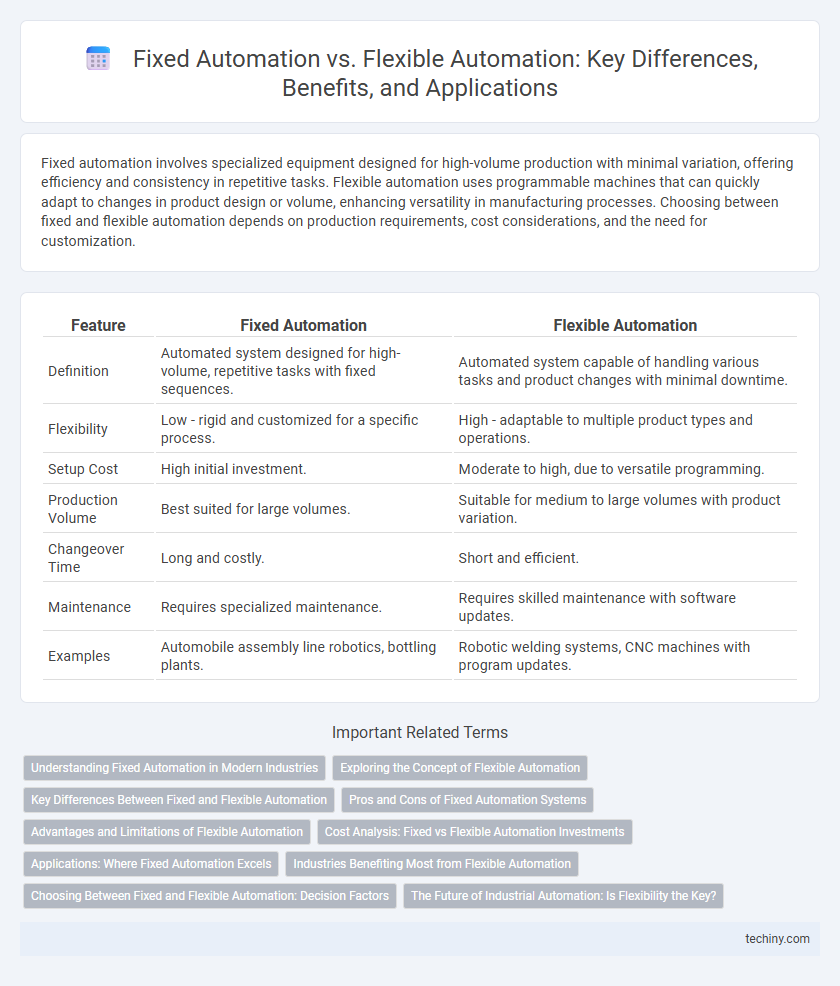Fixed automation involves specialized equipment designed for high-volume production with minimal variation, offering efficiency and consistency in repetitive tasks. Flexible automation uses programmable machines that can quickly adapt to changes in product design or volume, enhancing versatility in manufacturing processes. Choosing between fixed and flexible automation depends on production requirements, cost considerations, and the need for customization.
Table of Comparison
| Feature | Fixed Automation | Flexible Automation |
|---|---|---|
| Definition | Automated system designed for high-volume, repetitive tasks with fixed sequences. | Automated system capable of handling various tasks and product changes with minimal downtime. |
| Flexibility | Low - rigid and customized for a specific process. | High - adaptable to multiple product types and operations. |
| Setup Cost | High initial investment. | Moderate to high, due to versatile programming. |
| Production Volume | Best suited for large volumes. | Suitable for medium to large volumes with product variation. |
| Changeover Time | Long and costly. | Short and efficient. |
| Maintenance | Requires specialized maintenance. | Requires skilled maintenance with software updates. |
| Examples | Automobile assembly line robotics, bottling plants. | Robotic welding systems, CNC machines with program updates. |
Understanding Fixed Automation in Modern Industries
Fixed automation, characterized by high production volumes and dedicated equipment, excels in industries such as automotive manufacturing and consumer electronics, where repetitive tasks dominate. This automation type minimizes cycle times and reduces human intervention, significantly boosting efficiency and product consistency. Its rigidity limits adaptability to design changes, making it ideal for standardized, long-term production runs in modern industries.
Exploring the Concept of Flexible Automation
Flexible automation incorporates programmable machines that can adapt to various tasks without extensive reconfiguration, enabling rapid shifts in production processes. Unlike fixed automation, which relies on dedicated equipment for specific operations, flexible systems use robotics and computer-controlled machinery to handle multiple product variations efficiently. This adaptability reduces downtime and increases responsiveness to market changes, making flexible automation ideal for industries with diverse product lines or frequent design updates.
Key Differences Between Fixed and Flexible Automation
Fixed automation involves high production volume with specialized equipment designed for a specific task, offering high speed and low unit costs but limited adaptability. Flexible automation employs programmable machines capable of handling various operations, providing versatility and quick changeovers with moderate production rates. Key differences include fixed automation's rigidity versus flexible automation's adaptability, impacting scalability, cost efficiency, and suitability for product variety.
Pros and Cons of Fixed Automation Systems
Fixed automation systems excel in high-volume production with consistent product design, offering low unit costs and high operational speed due to specialized machinery. The main disadvantage lies in their inflexibility, as they are costly to modify or adapt to new products, leading to significant downtime and expenses during the reconfiguration process. These systems are ideal for industries like automotive manufacturing, where production runs are long and demand little variation.
Advantages and Limitations of Flexible Automation
Flexible automation offers significant advantages such as the ability to handle a variety of tasks and adapt quickly to product design changes, enhancing production versatility and reducing downtime. It supports small batch production and customization, making it ideal for industries with frequent product updates like automotive and electronics manufacturing. However, flexible automation has higher initial costs and complexity in programming and maintenance compared to fixed automation, which may limit its suitability for high-volume, repetitive tasks.
Cost Analysis: Fixed vs Flexible Automation Investments
Fixed automation involves high initial capital investment with minimal variable costs, ideal for high-volume, repetitive production processes. Flexible automation requires lower upfront costs but has higher operating expenses due to adaptability and frequent changeovers, making it suitable for varied product runs. Cost analysis reveals that fixed systems achieve economies of scale faster, whereas flexible systems offer cost advantages in dynamic manufacturing environments with diverse product demands.
Applications: Where Fixed Automation Excels
Fixed automation excels in high-volume production environments such as automotive assembly lines, where repetitive tasks demand consistent speed and precision. It is ideal for manufacturing standardized products like consumer electronics and packaged goods, ensuring maximum efficiency and minimal variation in output. Automated machinery in fixed setups enables significant cost reduction per unit when product design remains unchanged over long production runs.
Industries Benefiting Most from Flexible Automation
Automotive, electronics, and consumer goods industries benefit most from flexible automation due to their need for frequent product changes and customization. Flexible automation systems enable rapid adaptation to varying production requirements, reducing downtime and increasing efficiency. This adaptability supports high-mix, low-volume manufacturing environments, enhancing competitiveness in dynamic markets.
Choosing Between Fixed and Flexible Automation: Decision Factors
Choosing between fixed and flexible automation depends primarily on production volume, product variety, and cost considerations. Fixed automation is ideal for high-volume, standardized manufacturing due to its efficiency and lower unit cost, while flexible automation suits low-volume, high-variety production by enabling rapid product changeovers and customization. Decision factors include initial investment, scalability, lead time, and the ability to adapt to market demand fluctuations.
The Future of Industrial Automation: Is Flexibility the Key?
Fixed automation offers high efficiency and consistency for repetitive tasks but lacks adaptability to product variations. Flexible automation integrates programmable robotics and intelligent systems, enabling rapid reconfiguration to meet changing production demands. Emerging trends in AI-driven machine learning and IoT connectivity highlight flexibility as the crucial factor for future industrial automation competitiveness and resilience.
Fixed Automation vs Flexible Automation Infographic

 techiny.com
techiny.com